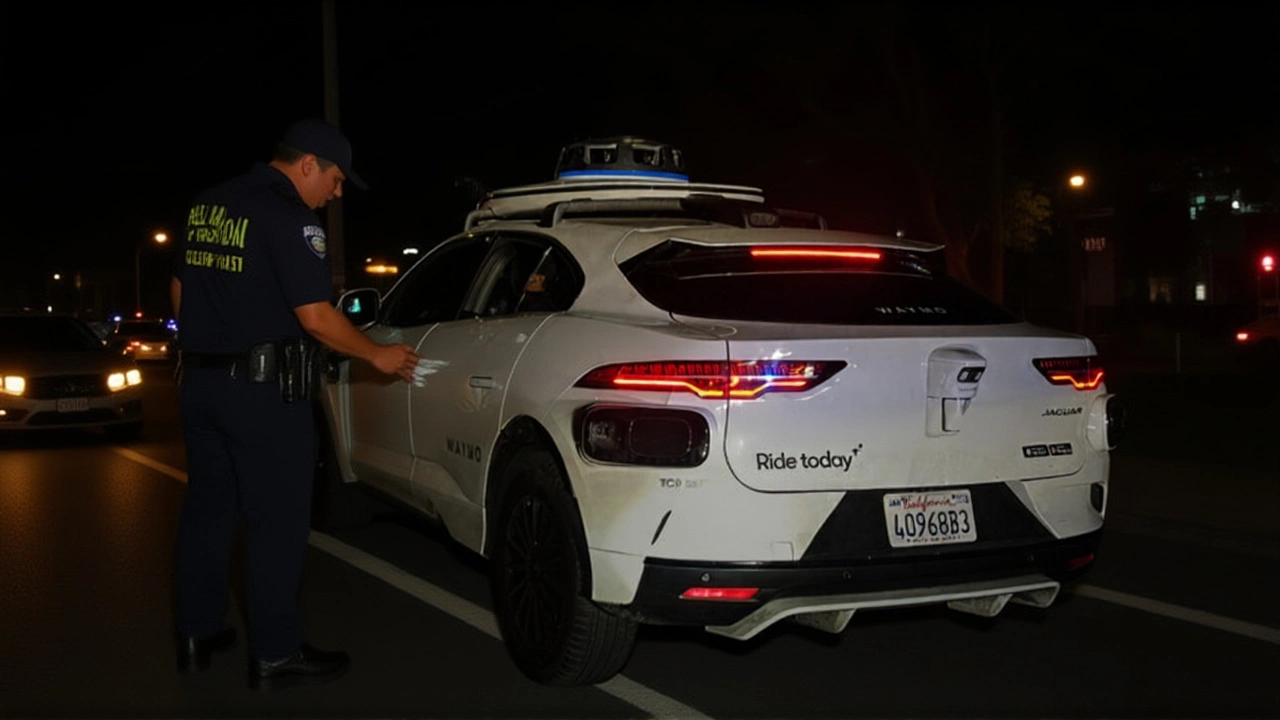When Waymo’s driverless taxi performed an illegal U‑turn during a Saturday‑morning DUI sweep, San Bruno police found themselves staring at an empty cabin and a citation book with no box for a robot.
On , San Bruno Police Department officers were conducting a routine traffic stop when the autonomous vehicle turned across their lane. The car rolled to the curb, activated its built‑in communication link, and connected the officers to a Waymo employee in seconds.
But when Sgt. Scott Smithmatungol approached the vehicle, he discovered no driver, no hands on the wheel and no human to hand a ticket to. "Our citation books don’t have a box for ‘robot,’" he told reporters, underscoring a legal gray area that has haunted regulators since the first driverless cars hit California’s streets.
Background: Waymo’s Expansion and Existing Rules
Founded in 2009 as the self‑driving arm of Alphabet, Waymo began commercial rides in the Bay Area in 2020 and has since added fleets in Austin, Texas and Atlanta, Georgia. The company’s promise is simple: a fleet of fully autonomous taxis that never need a human behind the wheel.
California’s vehicle code, however, still assumes a "driver" is a person. While the state gave police the authority in July 2025 to cite the **company** for moving violations, the law does not yet clarify how to handle a citation when no driver is present in the vehicle at the moment of the stop.
The Incident: What Actually Happened
As the DUI operation unfolded, the Waymo car, identified by its distinctive blue and white livery, executed a left turn onto El Camino Real that violated a red‑light indicator. Officers pulled the car over, and the vehicle’s onboard system automatically contacted Waymo’s operations center.
- Time of stop: 02:13 a.m.
- Location: Intersection of El Camino Real and Bay Road, San Bruno, California.
- Vehicle: Waymo XV3, model year 2025, fully autonomous (Level 4).
- Police response: No citation issued; incident reported to Waymo and state regulators.
Inside the cabin, officers saw a clean interior, a digital dashboard, and a small speaker that announced, "Connecting you to Waymo support." A Waymo operator answered within seconds, confirming the car had complied with the stop but acknowledging the U‑turn was a programming error.
Legal and Regulatory Landscape
Two pieces of legislation now frame the debate:
- California Autonomous Vehicle Accountability Act – Effective July 1 2025, this law permits police to issue moving‑violation citations directly to the autonomous‑vehicle company.
- 2026 DMV Reporting Initiative – Beginning January 2026, the California Department of Motor Vehicles will collect violation data from AV operators and may impose fines.
Despite these measures, the San Bruno stop highlighted a practical snag: officers can hand a ticket to a person, not a piece of software. The only remedy so far is to file a report and await a corporate response, which could trigger internal audits or software patches.

Reactions from Stakeholders
Waymo’s spokesperson, Sarah Patel, said the incident “provides valuable data that will help us refine our safety protocols.” She added that the company is already reviewing the navigation algorithm that caused the illegal turn.
Local residents, many of whom commented on the department’s viral social‑media post, were split. Some expressed relief that the car stopped safely, while others demanded accountability, writing, "If a human driver gets a ticket, why not the company?"
Kris Van Cleave, senior transportation correspondent for CBS News, noted, "This is the first time we’ve seen a police officer literally stare into an empty driver’s seat and wonder who to write a citation for. It forces regulators to confront a reality that’s been looming for years."
Looking Ahead: What This Means for Autonomous Mobility
The incident could accelerate the rollout of a standardized "AV citation protocol" that includes electronic ticketing to a corporate account, similar to parking tickets left on a vehicle. Legislators are already drafting language that would make an autonomous‑vehicle company the legal equivalent of a driver for the purposes of traffic law.
Waymo plans to launch a driverless service in Washington D.C. in 2026. If California’s new laws take effect smoothly, the capital could become a model for how cities enforce traffic rules on robot cars without needing a human behind the wheel.
Meanwhile, the San Bruno Police Department has added a new checkbox to its digital citation system labeled "Autonomous Vehicle – Company to be notified," a small but symbolic step toward closing the enforcement gap.
Frequently Asked Questions
How will police issue tickets to driverless cars in the future?
Upcoming state rules will let officers submit an electronic violation report that is automatically routed to the autonomous‑vehicle operator’s compliance team. The company can then pay fines or contest the ticket, much like a corporate fleet manager would today.
What does the "no driver, no hands, no clue" incident mean for Waymo’s safety record?
While the illegal U‑turn was a programming slip, the car still pulled over safely and communicated with police, which underscores the system’s core safety protocols. Waymo says the event will prompt a software update to prevent similar navigation errors.
When will the 2026 DMV reporting law take effect?
The law becomes active on January 1 2026. It requires autonomous‑vehicle operators to forward any moving‑violation data to the California Department of Motor Vehicles, which will then evaluate penalties and publish annual compliance reports.
Which other states are watching California’s approach?
Nevada, Arizona and Massachusetts have all filed their own autonomous‑vehicle legislation, but they have cited California’s emerging framework as a template for how to hold companies accountable for traffic violations.
Will passengers in driverless taxis be affected by these new laws?
Passengers won’t receive tickets, but companies could raise ride prices to cover potential fines. Regulators hope transparent reporting will keep costs low and maintain public trust in autonomous mobility.
